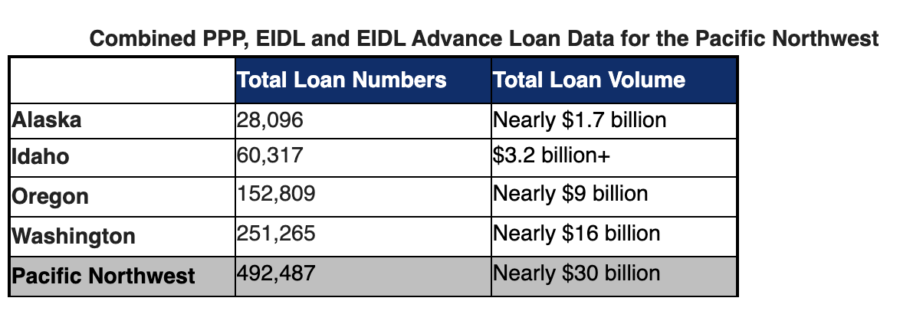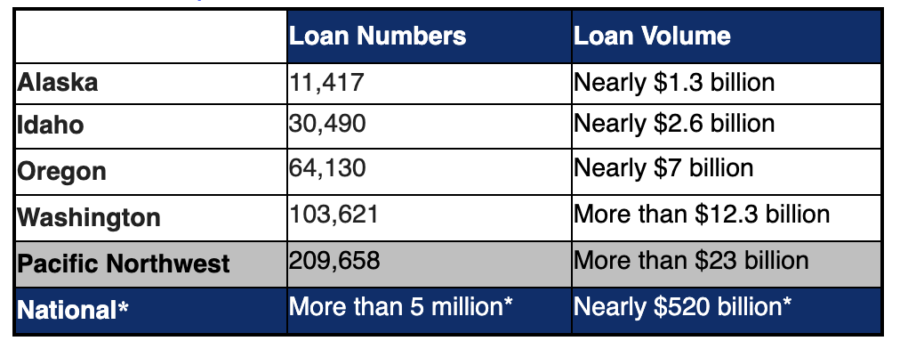SEATTLE – As part of economic relief efforts related to the Coronavirus pandemic, nearly $30 billion in Paycheck Protection Program (PPP) and Economic Injury Disaster Loan (EIDL) funds have been approved for small businesses and nonprofits in the U.S. Small Business Administration (SBA) Pacific Northwest Region serving Alaska, Idaho, Oregon, and Washington.
To put that in perspective, during the fiscal year 2019, the SBA approved $1.6 billion in the Pacific Northwest and $28 billion nationally as part of the agency’s traditional small business loan programs.

Nationally, the SBA has provided more than $660 billion in economic relief to small businesses across the country through the PPP, the EIDL, and the business loan debt relief program.
PPP Progress and Important Dates
According to SBA Administrator Jovita Carranza, the PPP alone has supported the employment of more than 50 million American workers and greater than 80% of the small business payroll across the country.
PPP Loan Data as of July 24, 2020
PPP reports available for download

*National data as of July 27, 2020
“More than 5,400 lenders nationwide stepped up to deliver PPP loans to small businesses, nonprofits, and the self-employed. During the past few months, lenders have worked with us long hours, late nights, and weekends to save America’s businesses and it’s paying off,” SBA Pacific Northwest Regional Administrator Jeremy Field. “Lenders have told me many stories about tears of joy and gratitude from their small business clients. Their individual stories validate the impactful data we’re seeing.”
The last day the SBA can accept new PPP applications is Friday, Aug. 8. However, Field advises local businesses and eligible organizations to start the PPP application process this week as connecting with a lender and compiling necessary paperwork can take some time.
He adds that the Aug. 8 deadline is for lenders to submit applications to the SBA for approval so a borrower needs to submit their application and paperwork ahead of that date. Borrowers will work with and apply to their lenders for PPP loan forgiveness. More information on PPP forgiveness is available at www.sba.gov/paycheckprotection.
SBA Debt Relief Another Financing Option
For small businesses that need additional financing beyond the PPP, the SBA will pay six months of principal, interest, and any associated fees that borrowers owe for all loans in its traditional lending programs – specifically 7(a), 504, and Microloans – disbursed prior to Sept. 27, 2020.
The agency has already been paying these fees for current 7(a), 504, and Microloans in regular servicing status.
“Access to capital has always been a top need for small businesses and that is even more so true as businesses navigate a new economic reality,” Field said. “As part of our agency’s relief efforts, we want more businesses to know of this added benefit to traditional SBA loan programs. Our network of lenders stepped up for the PPP and we will continue to work with them to provide small businesses financing through the SBA 7(a), 504, and Microloan programs.” More information about SBA Debt Relief is at www.sba.gov/coronavirusrelief.
EIDL Still Available for Businesses, Nonprofits
EIDL applications continue to be processed and accepted as another financing option for small businesses and nonprofits impacted by the Coronavirus pandemic.
In just three months, the SBA approved and disbursed nearly twice as many EIDL loans for COVID-19 than it has for all other disasters in the combined 67-year history of the agency.
EIDL and EIDL Advance Data as of July 15, 2020
Full EIDL and EIDL Advance reports available for download



